When I was around 13, I saw Point Break for the first time. It was a thrill-a-minute ride, a marker for teen boys in a hurry to grow up and let loose. There were countless gung-ho one-liners that made their mark after Johnny Utah (Keanu Reeves) lets surfing guru/Zen buddy/bank robber Bodhi (Patrick Swayze) paddle off into the 50-year storm in search of the ultimate wave. Among them, "100% pure adrenalin" and "F%^king am-a-zing" (as Utah skydives for what looks like the first time).
Where am I going with this? Well, one of the more philosophical contentions of the movie is when Bodhi is by the fire at his house and he utters this provocation. "If you want the ultimate, you've got to be willing to pay the ultimate price," he muses. "It's not tragic to die doing what you love."
That one isn't as easy to swallow unless you are the reckless and radical type but, 30 years later, it was front of mind as I got to gasp at another side of nature's ferocity. A power so gargantuan and devastating it humbles you. Zoom out and you'll see how inconsequential we really are, along with our trivial everyday gripes.
Sarah Dosa's awe-inspiring Fire of Love is about volcanologists Katia and Maurice Krafft. More than a documentary, it's a poetic meditation on the joy of devotion at the outer limits of obsession.
These nomadic adventurers spent around 25 years travelling the world, from Mount Stromboli in Italy to Mount Krafla in Iceland and Nevado del Ruiz in Columbia. They lived by the rhythms of the earth, running towards danger to study these natural phenomena (even deadly grey volcanoes with their pyroclastic flows).
In time, their research would avert major loss of life. It was their final recorded footage that helped to save thousands in the Philippines after the eruption of Mount Pinatubo in 1991. That Katia and Maurice were willing to give theirs a few weeks earlier by Mount Unzen in the pursuit of knowledge and understanding is incredible.
This wasn't a wholly altruistic endeavour. Living on the precipice, staring at the face of the fire, was immensely satisfying for the inseparable couple. Disillusioned with humanity in the wake of a second world war and the bloodshed in Vietnam, they had turned to the natural world for answers. Their revolt would be internal as much as external – yearning to feel more alive than ever at what felt like the centre of the earth.
Maurice was particularly vocal in how he had reconciled his own mortality with the huge risk before him. He hadn't set out to have a conventional life, he tells us, and welcomed the precarity of his profession, because life itself is precarious. "I prefer an intense and short life to a long and monotonous one," he says. "A kamikaze existence in the beauty of volcanic things."
Dosa calls the film a “love triangle” because of the Kraffts' differing outlooks on their pursuit, specifically the lengths they would be willing to go to. Katya could be circumspect, was research-driven, less impulsive, anticipating the long run. Maurice was more blasé about his welfare. But their shared passion always resolved any tension and renewed their alliance.
The final edit, forged in the depths of the pandemic and finessed in a productivity bubble at Dosa’s place, is culled from 180 hours of the Kraffts’ 16mm frames – work so breathtaking that they must be called filmmakers in their own right.
They also had access to 40-50 hours of interviews and 20 books that the Kraffts wrote. Early discussions between Dosa and co-producer Shane Boris helped to establish a tone, treatment and perspective on the production, which gives Fire of Love a thematic spine, an aura and sense of authorship.
Editors Erin Casper and Jocelyne Chaput deserve great credit for managing to construct a taut yet hynoptic rhythm that plays to the spectacle of the elements – amplified by a richly ambient soundtrack that features the likes of Brian Eno, Air’s Nicolas Godin and Jan Jelinek with a dash of Ennio Morricone – while allowing the personalities of the film’s charismatic and big-hearted stars to shine through.
The mood is somewhere between visceral and surreal, accented by flecks of genuine humour. Sure, blazing infernos and floods of lava are irresistible but ominous eye candy. But the Kraffts are magnetic in their own way, offering Wes Anderson-like moments full of mischief, whimsy and playfulness. More evocative of the Nouvelle Vague, if we’re taking it right back.
Maurice throwing a rock at an assistant to test his protective helmet is one of my favourite movie moments of 2022. Closely followed by the clip of an ashen-faced Katia as she turns and swigs on a water can before giving us an awkward eye like an unlikely hero from a TV show.
To guide us around the Kraffts’ world, Dosa and her colleagues envisaged a “deadpan curious” spirit. Miranda July embodies this and more, imbuing her enchanted and enchanting narration with the observational, inquisitive eye of a Truffaut or Cousteau voiceover.
Dosa said she didn't want people to focus on how Katia and Maurice died but rather how they lived. So July breaks the news to us early. That way, we can marvel at the cataclysmic power of the earth – and the “strange alchemy of the elements” – through the lens of our own fleeting existence.
When pressed about the wider significance of Fire of Love, what makes it enlightening to her in a deeper sense, the director says it asks us to reflect on what it is to live a meaningful life and to meet a meaningful end. Like the earth, we have the capacity to destroy or create. Which will it be?
What if we were to find this meaning in the natural world, to contemplate the mystery of its lifeforce, which courses under, over and around us? Respect its sentience, something Dosa explored in her previous film, the Seer and the Unseen, which led her to the Kraffts in the research stage. As July says, quoting Zen monk Thich Nhat Hanh, “Love is understanding’s other name.”
For me, it was a dare: to confront uncertainty and fear with curiosity and wonder. It’s the hyperreality check we all need.
The Kraffts also feature in Werner Herzog's Into The Inferno and are the subjects of his Storyville documentary The Fire Within, which is currently available to watch on the iPlayer. That latter is a “requiem”, bringing the destructive power of the earth to the forefront, which creates a heightened sense of impending doom.
The narration is more sparing, which lets the mind wander that little bit further. Watching the ground aglow, erupting, pouring down, blackening and folding in on itself to the sound of Ernst Reijseger’s enveloping compositions will get your heart racing like never before.
It’s also very humanistic in its own way as we glean more insight into the Kraffts’ working relationship and travels, and witness inhabitants of decimated areas grapple with the aftermath.
Fire of Love, which is now streaming on Disney+, feels more enthralling than elegiac, closer to them and their shared passion. But why choose? Treat one as a companion piece to the other.






